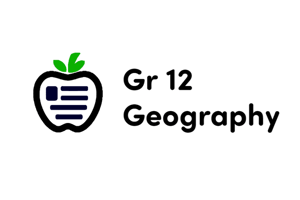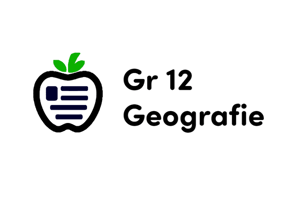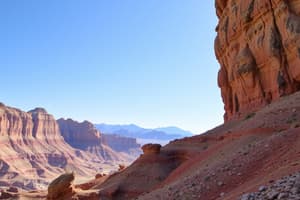Podcast
Questions and Answers
What is the main characteristic of Africa in terms of seismic activity?
What is the main characteristic of Africa in terms of seismic activity?
- Minimally seismically active (correct)
- Totally inactive
- Highly seismically active
- Moderately seismically active
When did the breakup of supercontinent Gondwana occur?
When did the breakup of supercontinent Gondwana occur?
- 100 million years ago
- 200 million years ago
- 150 million years ago
- 180 million years ago (correct)
What is the origin of the Ethiopian Highlands?
What is the origin of the Ethiopian Highlands?
- River delta origin
- Volcanic origin (correct)
- Tectonic uplift origin
- Fold mountain origin
What is the main characteristic of the Mediterranean coast?
What is the main characteristic of the Mediterranean coast?
Which mountain range is located in North Africa?
Which mountain range is located in North Africa?
What is the longest river in Africa?
What is the longest river in Africa?
What is the dominant process of weathering in humid tropical regions?
What is the dominant process of weathering in humid tropical regions?
What is the main concern in urban and industrial areas in terms of water pollution?
What is the main concern in urban and industrial areas in terms of water pollution?
What is the result of human activities such as agriculture and mining in terms of soil erosion?
What is the result of human activities such as agriculture and mining in terms of soil erosion?
What is the main characteristic of the Sahara Desert?
What is the main characteristic of the Sahara Desert?
Flashcards are hidden until you start studying
Study Notes
Geomorphology of Africa
Tectonic Evolution
- Africa is a tectonically stable continent, with minimal seismic activity
- Formed from the breakup of supercontinent Gondwana, around 180 million years ago
- Major tectonic events:
- African Rift System (ARS) formation, 20-30 million years ago
- East African Rift System (EARS) formation, 10-20 million years ago
Physiographic Regions
- Highlands
- Ethiopian Highlands: volcanic origin, uplifted during the EARS formation
- Drakensberg Mountains: formed during the Gondwana breakup
- Lowlands
- Congo Basin: formed from the Congo River and its tributaries
- Nile River Basin: formed from the Nile River and its tributaries
- Coastal Regions
- Mediterranean coast: characterized by folded mountains and narrow coastal plains
- Atlantic coast: characterized by narrow coastal plains and low-lying relief
Landforms and Features
- Mountains
- Atlas Mountains: fold mountains in North Africa
- Drakensberg Mountains: highest peak in Southern Africa
- Rivers
- Nile River: longest river in Africa, flows from Lake Victoria to the Mediterranean
- Congo River: second-longest river in Africa, flows from the Congo Basin to the Atlantic
- Deserts
- Sahara Desert: largest hot desert in the world, covering North Africa
- Namib Desert: coastal desert in Southern Africa
Geological Processes
- Weathering
- Chemical weathering: dominant process in humid tropical regions
- Mechanical weathering: dominant process in arid and semi-arid regions
- Erosion
- Fluvial erosion: significant in river basins and valleys
- Aeolian erosion: significant in desert regions
- Deposition
- Fluvial deposition: forms deltas and floodplains
- Aeolian deposition: forms sand dunes and loess deposits
Human Impact
- Deforestation
- Widespread in tropical regions, leading to soil erosion and land degradation
- Soil Erosion
- Accelerated by human activities, such as agriculture and mining
- Water Pollution
- Major concern in urban and industrial areas, affecting river and lake ecosystems
Tectonic Evolution of Africa
- Africa is a tectonically stable continent with minimal seismic activity
- Formed from the breakup of supercontinent Gondwana, around 180 million years ago
- Major tectonic events include the African Rift System (ARS) formation, 20-30 million years ago, and the East African Rift System (EARS) formation, 10-20 million years ago
Physiographic Regions of Africa
- Highlands include the Ethiopian Highlands, formed from volcanic origin and uplifted during the EARS formation, and the Drakensberg Mountains, formed during the Gondwana breakup
- Lowlands include the Congo Basin, formed from the Congo River and its tributaries, and the Nile River Basin, formed from the Nile River and its tributaries
- Coastal Regions include the Mediterranean coast, characterized by folded mountains and narrow coastal plains, and the Atlantic coast, characterized by narrow coastal plains and low-lying relief
Landforms and Features of Africa
- Mountains include the Atlas Mountains, fold mountains in North Africa, and the Drakensberg Mountains, the highest peak in Southern Africa
- Rivers include the Nile River, the longest river in Africa, flowing from Lake Victoria to the Mediterranean, and the Congo River, the second-longest river in Africa, flowing from the Congo Basin to the Atlantic
- Deserts include the Sahara Desert, the largest hot desert in the world, covering North Africa, and the Namib Desert, a coastal desert in Southern Africa
Geological Processes in Africa
- Weathering processes include chemical weathering, dominant in humid tropical regions, and mechanical weathering, dominant in arid and semi-arid regions
- Erosion processes include fluvial erosion, significant in river basins and valleys, and aeolian erosion, significant in desert regions
- Deposition processes include fluvial deposition, forming deltas and floodplains, and aeolian deposition, forming sand dunes and loess deposits
Human Impact on Africa's Environment
- Deforestation is widespread in tropical regions, leading to soil erosion and land degradation
- Soil erosion is accelerated by human activities, such as agriculture and mining
- Water pollution is a major concern in urban and industrial areas, affecting river and lake ecosystems
Studying That Suits You
Use AI to generate personalized quizzes and flashcards to suit your learning preferences.




